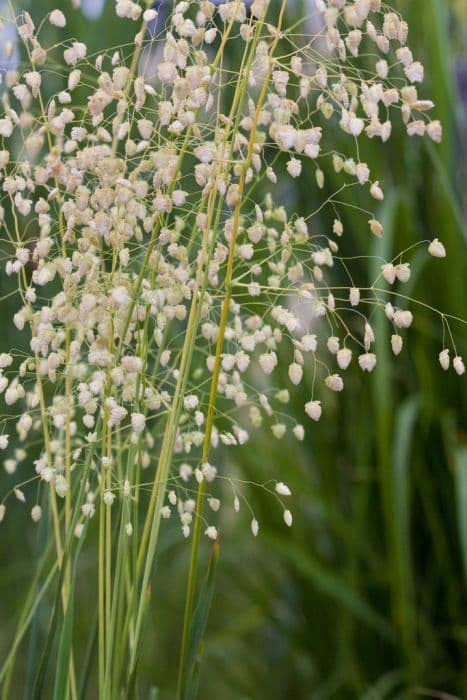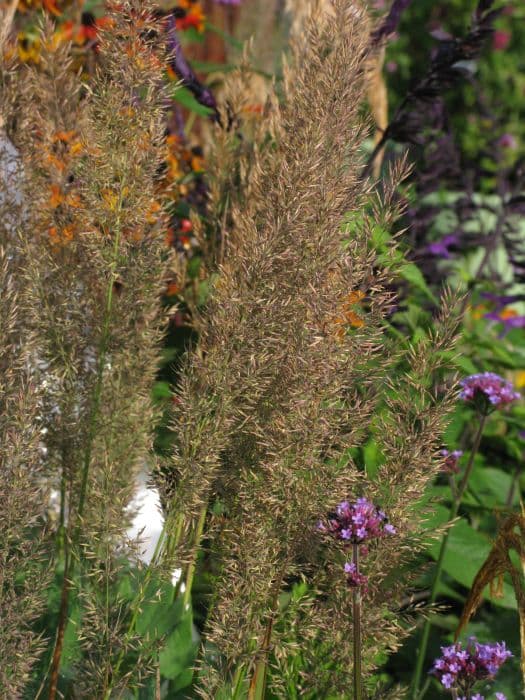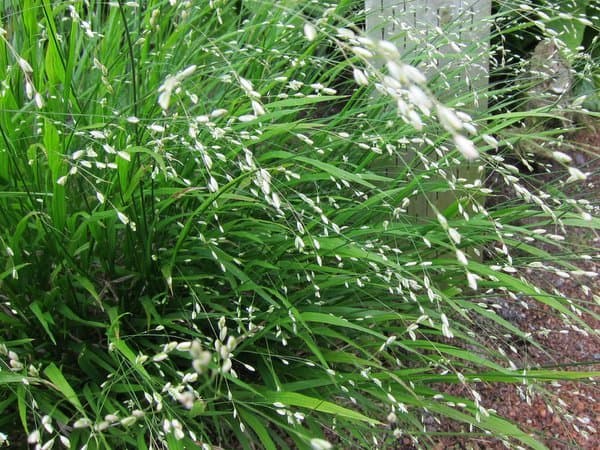Large-leaf Bamboo Indocalamus tessellatus

ABOUT
Indocalamus tessellatus, commonly known as large-leaf bamboo, is distinguished by its broad and expansive leaves, which are among the largest of any bamboo variety. The leaves have a distinctive, lush green color and texture, which can provide a bold tropical aesthetic to any garden or space where the plant is grown. Despite being a bamboo species, it does not resemble the thin, reedy leaves commonly associated with such plants. Instead, the leaves of the large-leaf bamboo have a somewhat elongated shape, tapering smoothly to a point at the end while remaining broad along their length. Aside from its unmistakable leaves, the large-leaf bamboo also has sturdy and resilient culms, which are the bamboo's equivalent to stems. These culms are typically a soothing green color, sometimes showcasing a powdery white bloom which gives them a frosted appearance. The culms carry the substantial foliage in a manner that allows the leaves to cascade gracefully, lending a serene and inviting presence to its overall look. The combination of striking leaves and the supportive framework of the culms results in a plant that exudes an air of the exotic and can contribute significantly to the ambiance of its chosen surroundings.
About this plant
 Names
NamesFamily
Poaceae
Synonyms
Large-Leaf Bamboo, Broad-Leaved Bamboo
Common names
Arundinaria tessellata, Bambusa tessellata, Teinostachyum tessellatum, Sinarundinaria tessellata.
 Toxicity
ToxicityTo humans
The plant known as large-leaved bamboo is not commonly recognized for being toxic to humans. There are no well-documented cases or widespread concerns regarding its toxicity, and it does not appear on lists of poisonous plants. Consequently, eating or touching large-leaved bamboo is unlikely to cause poisoning in humans. However, as with any plant, individual allergies or sensitivities can cause mild to severe reactions, and it's generally advisable to avoid ingesting plants that are not confirmed as safe to eat.
To pets
Large-leaved bamboo is not known to be toxic to pets either. It doesn't appear on the toxic plant lists provided by organizations like the ASPCA (American Society for the Prevention of Cruelty to Animals). Thus, it is generally considered safe for pets, including cats and dogs. However, ingestion of non-food items by pets can sometimes lead to gastrointestinal discomfort or blockages, depending on the amount consumed and the size of the animal. As always, it is best to monitor pets for any sign of adverse reaction when they ingest plant material.
 Characteristics
CharacteristicsLife cycle
Perennials
Foliage type
Evergreen
Color of leaves
Green
Height
5 feet [1.5 meters]
Spread
6 feet [1.8 meters]
Plant type
Herb
Hardiness zones
7
Native area
China
Benefits
 General Benefits
General Benefits- Landscape Beautification: Big Leaf Bamboo adds an aesthetic value to gardens with its large, tessellated leaves and can act as a focal point or backdrop.
- Shade Provision: Due to its size and dense foliage, Big Leaf Bamboo is effective at providing shade in gardens or patios.
- Noise Reduction: The rustling leaves and dense growth habit can diminish noise pollution, creating a more tranquil environment.
- Windbreak: The sturdy clumps of Big Leaf Bamboo can serve as a windbreak, protecting delicate plants and reducing soil erosion.
- Privacy Screen: With its tall and dense growth, it can act as a living privacy screen, shielding spaces from outside view.
- Erosion Control: The root system helps in stabilizing slopes and preventing soil erosion in landscaped areas.
- Habitat for Wildlife: Provides food and shelter for various species of birds, insects, and small mammals.
- Ornamental Crafts: The canes and leaves can be used for making decorative items and crafts.
 Medical Properties
Medical Properties- Antioxidant properties: Indocalamus tessellatus leaves contain flavonoids and phenolic compounds which are known for their antioxidant activity.
- Anti-inflammatory effects: The plant may have compounds that can help reduce inflammation.
- Gastric ulcer prevention: Extracts from the plant have been used to protect against gastric ulcers in some traditional medicine systems.
- Antimicrobial activity: There are indications that Indocalamus tessellatus has antimicrobial effects against certain bacteria and fungi.
 Air-purifying Qualities
Air-purifying QualitiesThis plant is not specifically known for air purifying qualities.
 Other Uses
Other Uses- Edible shoots: The young shoots of Indocalamus tessellatus, commonly known as bigleaf bamboo, can be consumed after proper processing to reduce bitterness and potential toxins.
- Craft material: The large leaves and flexible canes of bigleaf bamboo can be used to make a variety of crafts including baskets, mats, and even small furniture items.
- Fodder for animals: Bigleaf bamboo leaves and culms can be used as feed for livestock, providing a nutritional supplement for animals like goats and cows.
- Sound insulation: The dense growth habit and large leaves of bigleaf bamboo can be employed as a natural sound barrier in landscaping.
- Textile production: Fine fibers extracted from the leaves and shoots of bigleaf bamboo can be spun into yarn and then woven into textiles.
- Ornamental uses: With its large, attractive leaves, bigleaf bamboo is often used in gardens and public spaces for ornamental purposes.
- Erosion control: The robust root system of the bigleaf bamboo helps stabilize the soil, making it a good candidate for preventing erosion on slopes and banks.
- Privacy screens: The tall and dense nature of bigleaf bamboo makes it ideal for creating living privacy screens in residential areas.
- Water filtration: Bigleaf bamboo can be planted near water sources to help reduce nutrient runoff and sediment, aiding in natural water purification.
- Windbreaks: The sturdy culms of bigleaf bamboo are effective at reducing wind speed and protecting more delicate plants in gardens or agricultural settings.
Interesting Facts
 Feng Shui
Feng ShuiThe plant Indocalamus tessellatus, more commonly known as Big Leaf Bamboo, is not commonly mentioned in traditional Feng Shui practice.
 Zodiac Sign Compitability
Zodiac Sign CompitabilityThe Big Leaf Bamboo is not used in astrology practice.
 Plant Symbolism
Plant Symbolism- Resilience: The tough and persistent growth of the plant symbolizes resilience, teaching us to bend but not break in the face of adversity.
- Simplicity: Known as a simple and unpretentious plant, it stands for leading a life characterized by simplicity and devoid of unnecessary complication.
- Flexibility: Its ability to sway with the breeze without snapping reflects the quality of being adaptable and flexible in one's life.
- Longevity: As a species of bamboo, it represents long life and is often associated with longevity in various cultural traditions.
- Peace: The gentle appearance and soft rustle of its leaves in the wind can symbolize peace and tranquility.
- Good Fortune: In some cultures, bamboo plants like Indocalamus tessellatus symbolize good luck and prosperity.
 Water
WaterBig Leaf Bamboo prefers consistent moisture and should be watered deeply once a week, providing about an inch of water at each session. The soil should remain moist but not waterlogged. During hot or dry spells, increase watering to twice per week. In the winter months, reduce watering slightly as the plant's growth slows, but do not allow the soil to completely dry out. Ensure the plant receives a total of 4-6 gallons of water each month.
 Light
LightBig Leaf Bamboo thrives in partial to full shade, making it ideal for spots that don't receive harsh direct sunlight. The best location would be under the canopy of larger trees or on the north side of a building where it gets filtered light. An area that mimics its natural understory habitat will contribute to its growth and vitality.
 Temperature
TemperatureBig Leaf Bamboo performs well in a wide range of temperatures, typically between 15°F and 90°F. The plant can withstand brief periods of cooler weather, but it is not frost-tolerant and should be protected if temperatures dip below the minimum range. The ideal temperature for Big Leaf Bamboo is a comfortable 60°F to 80°F.
 Pruning
PruningPruning Big Leaf Bamboo is primarily done to remove dead or damaged canes and to manage its size or shape. The best time for pruning is in the late winter or early spring before the new growth begins. Pruning once a year is usually enough to keep the plant looking tidy and maintain its health.
 Cleaning
CleaningAs needed
 Soil
SoilBig Leaf Bamboo prefers fertile, loamy soil with good drainage and a slightly acidic to neutral pH between 6.0 and 7.0. A soil mix rich in organic matter, such as a blend of garden soil, compost, and sand or perlite for aeration, is ideal, ensuring moisture retention without waterlogging.
 Repotting
RepottingBig Leaf Bamboo should be repotted every two to three years to prevent it from becoming root-bound and to replenish its nutrients. Spring is the best time to repot this plant, allowing it to recover during the growing season.
 Humidity & Misting
Humidity & MistingBig Leaf Bamboo thrives in moderate to high humidity conditions. Maintaining a relative humidity around 50-60% is beneficial for the plant's health, as it simulates the humid environment of its natural habitat.
 Suitable locations
Suitable locationsIndoor
Place Big Leaf Bamboo near a window, avoid direct sun.
Outdoor
Plant in partial shade with wind protection.
Hardiness zone
7-10 USDA
 Life cycle
Life cycleIndocalamus tessellatus, commonly known as large-leaf bamboo, starts its life as a seed, although it primarily propagates via rhizomes. After germination, the seedling grows into a young plant with a short rhizome system. As it matures, the bamboo develops a network of underground rhizomes, which spread and produce shoots called culms. These culms grow upwards rapidly, hardening and maturing into the bamboo's characteristic woody stems with large leaves. The plant reaches reproductive maturity and can produce flowers, though flowering is rare and sporadic, often occurring in cycles of many years. After blooming, if sexual reproduction occurs, seeds are produced before the parent plant typically begins to decline, completing its life cycle.
 Propogation
PropogationPropogation time
Spring-Early Summer
Propogation: Indocalamus tessellatus, commonly known as Large-Leaf Bamboo, is most commonly propagated through division, a straightforward process typically performed in the spring as the growing season commences. To propagate by division, carefully excavate around a hearty clump of the bamboo, ensuring to include a generous portion of roots and shoots, then use a sharp shovel or spade to cut through the rhizomes to separate a section. The division should have at least one culm, or bamboo stalk, and a sufficient root mass to sustain the transplanted section. Plant the new bamboo division in a prepared hole, covering the roots to the same depth they were grown previously, and water thoroughly—it's often recommended to use about a gallon (3.8 liters) of water immediately after planting to help establish the division. This method is effective for expanding one's collection of Large-Leaf Bamboo or distributing it to other locations.









